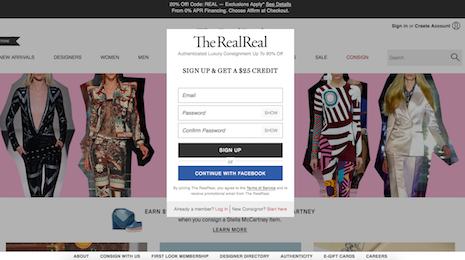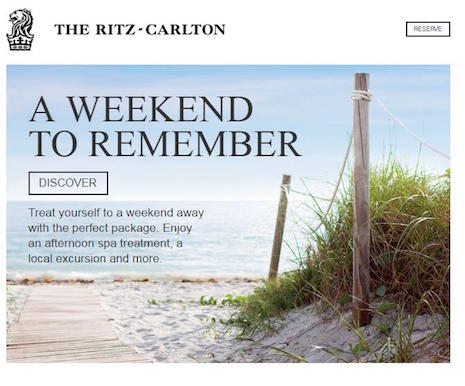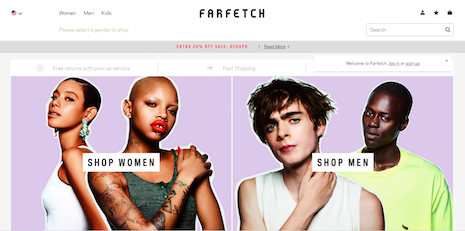 The RealReal asks for opt-in data immediately upon site entrance.
The RealReal asks for opt-in data immediately upon site entrance.
NEW YORK - Luxury brands can struggle to use data for personalization, as these houses who are significantly rooted in heritage find themselves having to compete with savvy labels born in the analytical age who inherently understand how to leverage artificial intelligence.
During the “Data-Driven Marketing in Luxury” panel at Luxury Marketing Forum on Sept. 26, the director for the North Carolina State University luxury program emphasized how important it is for executives in luxury to think analytically, business-like and luxury-minded all at once. Luxury is just now getting a feel for one-to-one marketing, which offers a significant mining potential to capture luxury consumers.
“There are all sorts of ways to collect data on your customer,” said Kristie McGowan, director for global luxury and management at North Carolina State University. “It used to be that analytics was just about what size, style and color did they purchase, but now it is about what platforms are they using, what questions are they asking?”
Luxury Marketing Forum was organized by Luxury Daily, with venue sponsor UBS
Luxury gets personal
With so much data at companies’ fingertips, the options for personalizing the shopping experience are almost endless.
During the panel, moderated by Bob Shullman, founder and CEO of Shullman Research, George Pappachen, U.S. president for BiScience, mentioned that luxury brands are still trying to test one-to-one marketing without being intrusive or tainting their brand image by annoying consumers. Luxury labels are primarily looking to email for this personalization tactic.
 Sands of time, Ritz-Carlton email.
Sands of time, Ritz-Carlton email.
Ms. McGowan followed up by explaining how within the global luxury and management program at North Carolina State, the student curriculum is designed to create executives in luxury who can think analytically in the space of luxury and business. However, this can be contradictory since luxury is heavily rooted in heritage.
Chief design and development officer of Berkshire Hathaway's Richline Group luxury division Alberto Milani explained companies must embrace data collection. But the concept steps away from the historic manner in which luxury businesses have operated for years, which has caused the jewelry and luxury sectors to fall behind.
Mass brands are making strides in one-to-one marketing and how to react to data points in a way that luxury needs to learn from. Burberry is one of the luxury brands that is learning to pivot towards this strategy with a variety of digital tactics and using video in unique ways and leveraging data for detailed messaging.
Using data to answer the question, “Who is my audience?” is imperative, but tapping analytics to determine how to tailor marketing to this person is important as well.
Luxury retailers such as Farfetch and Net-A-Porter are doing significantly well, cited Ms. McGowan, thanks to being born in the digital and analytical era.
 Is Farfetch's model a fit for other markets? Image credit: Farfetch
Is Farfetch's model a fit for other markets? Image credit: Farfetch
A few heritage brands are figuring out how to adapt into this new environment by learning to track every interaction with the consumer in new ways as well.
For instance, Montblanc has tracked cameras in their stores to determine where the most foot traffic is and how it can leverage this to better serve its bricks-and-mortar visitors.
Rebecca Minkoff is one of the luxury brands and retailers who are leveraging smart fitting room mirrors to help consumers. But these smart mirrors do more than assist customers while in-store, as they also help relay data and information back to the brand.
According to Mr. Milani, the most important aspect of marketing with data today is whether or not the message is relevant to the consumer no matter the platform.
Data-driven marketing
Hilton’s Waldorf Astoria Hotels & Resorts recently launched its first digital-led campaign motivated by consumer insight data as rapidly changing luxury travel trends shift how travel brands need to cater to affluent guests.
The “Live Unforgettable” campaign playfully highlights Waldorf Astoria’s commitment to service in three 15-second spots, with each storyline featuring the concierge helping to fulfill customers' offbeat requests. Waldorf's commitment to evolving its strategy around consumer insight with this campaign exhibits the necessity to adapt to the new normal for luxury travel brands, and using data to do so (see story).
Luxury linen maker Matouk experienced more than a 200 percent increase in ROI over six months after increasing its use of data analytics.
According to Matouk, a comprehensive view of sales and ROI data has led the brand to make stronger decisions and have a better understand of how it should invest resources. This is yet another example of how data analytics can be immensely helpful for luxury brands as they seek to gain an advantage over competitors (see story).
“Those between 18 and 34 years old are 35 percent of the work force today in the U.S.," Mr. Milani said. “These are the people who are going to have the money.
“These are the people we have to talk to,” he said. “It is a matter of understanding language and how it is different, because obviously the tools today were not available 15 years ago.
“The marketing message has to be relevant. It can be on paper, it can be on TV, but if it's not relevant it's not worth it.”